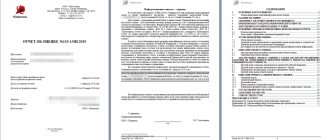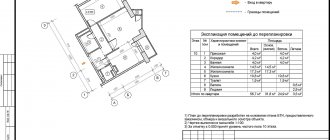4.1. Cost approach methods
4.1.1.
The component breakdown method is a method of calculating the cost of a building as the sum of the costs of its individual components (foundations, walls, floors, etc.):
C = ∑ i = 1 n C i {\displaystyle C=\sum _{i=1}^{n}C_{i}}
where: C {\displaystyle C} is the cost of the building, den. units; C i {\displaystyle C_{i}} — cost of the i-th component, den. units
4.1.2.
Comparative unit method - the method involves calculating the cost of constructing a comparative unit (1 sq. m., 1 cubic meter) of a similar object. To calculate the full cost of the assessed object, the adjusted cost of the comparison unit is multiplied by the number of units (area, volume):
C = CCE × N {\displaystyle C=C_{CE}\times N}
where: C {\displaystyle C} is the cost of the comparative unit, den. unit/unit; CCE {\displaystyle C_{CE}} - number of comparative units in the object, units.
4.1.3.
Quantitative survey method is a method of calculating the value of a building based on a detailed quantitative and cost calculation of the costs of installing individual components, equipment and constructing the building as a whole (for example, by drawing up an estimate).
4.2. Costs of creating real estate objects
4.2.1.
Reproduction costs (excluding wear and tear and obsolescence) are the costs of creating a copy of an existing object using the same construction project and similar building materials (excluding wear and tear and obsolescence of the property being assessed).
Synonyms: total cost of reproduction, cost of reproduction
4.2.2.
Replacement costs (excluding depreciation and obsolescence) are the costs of constructing a facility of similar or comparable utility, using designs and materials currently in use on the market (excluding depreciation and obsolescence of the property being assessed). Synonyms: full replacement cost, replacement cost.
4.2.3.
Often, when determining the value of replacement (reproduction) costs, cost data related to the retrospective period and requiring indexation is used (see clause 2.12).
Types of main indices used in valuation practice to calculate the cost of reproduction and replacement of land improvements:
Table 11.
| No. | Name | A comment |
| 1 | Average price change index for Russia as a whole. | The most aggregated index, theoretically, provides the lowest accuracy of calculations. |
| 2 | Indices of price changes for construction and installation work by region | |
| 3 | Price change indices for structural systems by region | An index that most fully takes into account the characteristics of a specific construction project and, theoretically, ensures the greatest accuracy of calculations. |
The following can be used as an indexed value:
- data from price reference books in construction,
- accounting data for a specific object,
- data obtained from the open market for comparable construction projects.
When using accounting data, as a rule, the original book value is selected as the indexed value, which allows one to obtain the value of replacement or reproduction costs without taking into account wear and tear and obsolescence.
Initial book value (initial cost) is the amount of the organization's actual costs for the acquisition, construction and production of fixed assets, with the exception of value added tax and other refundable taxes, reflected in the organization's accounting records.
Residual book value (residual value) is the difference between the original cost of a fixed asset and accrued depreciation for the period between the date of placement on the balance sheet and the reporting date, reflected in the accounting of the inventory position.
4.2.4.
Over-improvements are elements of a property whose contribution to the value is less than the cost of their creation.
4.2.5.
What to pay attention to in appraisal practice:
- When determining market value, the behavior of typical market subjects is modeled. A typical buyer, first of all, focuses on the usefulness of the object, and not on the materials and technologies used in its creation. For this reason, determining the market value of real estate under the cost approach to valuation is typically based on replacement costs;
- As a rule, for the same object, the value of replacement costs is less than the value of reproduction costs.
Advantages and disadvantages of the cost approach to real estate valuation
The advantages of the indicated approach lie in its reliability when used in the assessment of new buildings or residential and non-residential complexes and elements that have been in operation for 3-5 years. It also has an advantage when the real estate market is weak.
Disadvantages include:
- In conditions of indexing prices for building materials and equipment operation, it is difficult to identify an adequate indicator of the costs of producing an object.
- Regarding the comparative approach, it is labor-intensive, requiring many calculations, sometimes with the same result of estimation accuracy.
- When assessing buildings and premises that have been in use for more than 7 years, it practically does not provide an up-to-date indicator due to objective reasons.
- The reliable results obtained may differ from the prices set by the market, which indicates the futility of its use.
In addition to the above, it is necessary to note the indispensability of this method when assessing unique objects or conducting an examination of their technical and economic condition.
If analogues required for information support of the comparative approach are not found in the real estate market, one has to resort to a costly one.
The tax or insurance authorities can base the corresponding deductions only on the basis of the cost approach, which refers to the officially recognized methods of valuing real estate. State developments, when planning costs for the construction of objects, also focus only on the indicators obtained as a result of applying the indicated approach.
4.7. Profit of an entrepreneur (developer)
4.7.1.
Entrepreneur's profit (developer's profit) is the entrepreneur's (developer's) remuneration for the risk of using his own capital (investment) to create a real estate property. In the methodological literature there is no clear position on who exactly is meant by “entrepreneur”. Usually it is understood as an entity that invests its own funds in the relevant project (entrepreneur, investor, developer, builder).
It is necessary to separate the profit of entrepreneurs and the profit of the contracting organization that performs certain work on the construction of the facility. Integrated indicators of construction costs from most collections include the amount of profit of the contractor.
4.7.2.
The amount of profit of an entrepreneur is determined on the basis of market information, taking into account direct, indirect and opportunity costs associated with the creation of capital construction projects and the acquisition of rights to a land plot using methods (clause “z”, clause 24 of FSO No. 7 [5]}):
- extraction,
- expert assessments
- analytical models.
4.7.3. The entrepreneur’s profit can be indicated both for the project as a whole, and in terms of a single period of time (usually a year). The relationship between them is as follows:
PPPER = ( 1 + PPPR ) n − 1 , {\displaystyle PP_{PER}={\sqrt[{n}]{(1+PP_{PR)}}}-1,}
where: PP per {\displaystyle PP_{per}} is the entrepreneur’s profit for the period, shares of units; PP pr {\displaystyle PP_{pr}} — entrepreneur’s profit for the project, shares of units; n {\displaystyle n} — number of periods for the entire duration of the project, units.
Example task. The entrepreneur sold the constructed property for 40% more than the amount of funds he invested. Determine the annual profit of the entrepreneur if the total duration of the project is 3 years.
Solution:
PPPER = ( 1 + 0 , 4 ) 3 − 1 = 0 , 119 , {\displaystyle PP_{PER}={\sqrt[{3}]{(1+0.4)}}-1=0.119,}
Valuation of land using a cost-based approach
A site with newly drawn boundaries, without traces of visible activity of the owner, is not assessed according to the established criteria.
But here, too, these methods are reflected in the ratio of investment in the acquisition and capitalization of land, which acts as a commercial offer, being equated to similar plots put up for auction.
Here the development cost method should be used, which allows for a greater or lesser degree of capital investment, which determines the increase or decrease in price when selling the storage unit.
It is advisable to use the cost approach on lands with installed capital structures or that have undergone other inseparable improvements.
The replacement cost of the land is deducted from the sum: the market price of the plot without improvements, with the addition of the replacement or replacement cost of the objects installed on the land plot.
In addition to buildings, buildings and structures, inseparable improvements may include:
- land reclamation;
- properties of increased soil fertility, their fertilization;
- storage location;
- transport and engineering communications;
- the buildings;
- perennial fruit-bearing trees;
- landscape and environmental friendliness of the area.
These and other improvements are considered in conjunction with the storage category and intended purpose. When justifying the proportionality of the established price, it is necessary to highlight those advantages that are reflected in the context of the intended use of the storage device as additionally acquired advantages.
4.8. Service life, age of objects
4.8.1.
Service life (economic service life, service life, full service life, economic life) is the time period from the moment of creation of an object until its use is economically feasible. It may either coincide with the lifespan or be less than it.
4.8.2.
Life span (physical life span, full life span) – the full lifespan of the property.
4.8.3.
Residual physical life span (remaining physical life span) – The difference between the full and actual life span.
4.8.4.
Standard service life (life) is the service life of an object, which is defined in regulations for the conditions of normal operation of the object.
4.8.5.
Chronological age (actual age) is the time period that has passed from the commissioning of an object (or manufacture) to the current moment (or date of assessment).
4.8.6.
Effective age:
- the difference between the full economic life of a property and its remaining economic life;
- time by which the life expectancy of an object is estimated, depending on its physical condition, equipment, design, economic factors affecting its value.
4.8.7
.
Residual service life (remaining service life, remaining economic service life, residual economic service life) is the time period from the current moment (or date of assessment) until the moment when the use of the object is economically feasible. Navigation in the “real estate” section:
general topics, basic concepts, income approach,
cost approach , comparative approach, land valuation, other, recommended sources, glossary - real estate
Rent valuation using the cost approach
Calculation of payments for rental property also allows for the use of a cost approach. This takes into account the specifics of the property and the intended use of the lease, which requires the selection of more accurate calculation methods.
When leasing land by a developer, in addition to the indicated calculation standards, sometimes the method of investment contracts is also used. Its use is advisable in large cities, with an organized system of interaction between the customer, developer and investor. The contract includes provisions for the transfer of part of the building or other elements to the customer.
They can be parking, non-residential areas of the ground floor intended for commercial purposes, or a specified volume of residential areas (see Non-residential premises in a residential building).
Based on the transfer of the finished product, it is allowed:
Deduct from the rental amount the estimated cost of the finished product transferred to the lessor under the terms of the contract.
Divide the rent as a percentage between participants to receive profit in the form of a finished product. In this case, the investment agreement also provides for responsibility for paying the costs of constructing the building.
In other cases, the cost approach is focused on analogies of rental relations, also using the methods of the comparative approach.
This is due to the lessor’s position on establishing standards and regulations for the transfer of lease rights.






